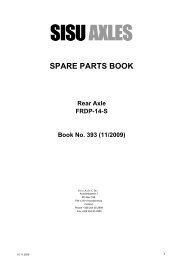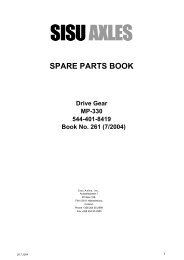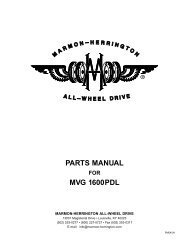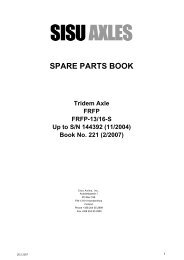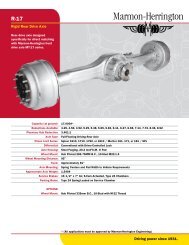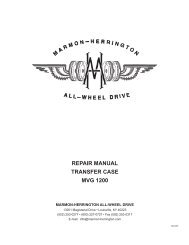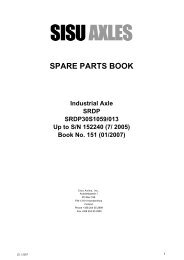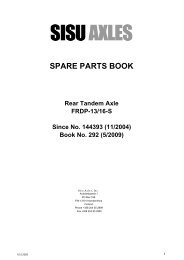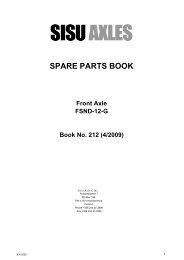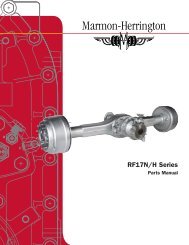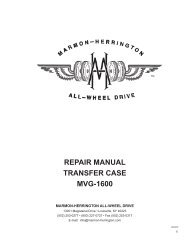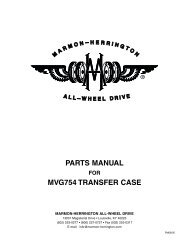SISU MP-330 DRIVE GEAR Maintenance Manual - Marmon ...
SISU MP-330 DRIVE GEAR Maintenance Manual - Marmon ...
SISU MP-330 DRIVE GEAR Maintenance Manual - Marmon ...
Create successful ePaper yourself
Turn your PDF publications into a flip-book with our unique Google optimized e-Paper software.
<strong>SISU</strong> <strong>MP</strong>-<strong>330</strong><br />
<strong>DRIVE</strong> <strong>GEAR</strong><br />
<strong>Maintenance</strong> <strong>Manual</strong><br />
Sisu Axles, Inc.<br />
Autotehtaantie 1<br />
PO Box 189<br />
Fin-13101 Hameenlinna<br />
Finland<br />
Phone +358 204 55 2999<br />
Fax +358 204 55 2900<br />
<strong>MP</strong><strong>330</strong>DG.PDF (4/2007)
<strong>Maintenance</strong> <strong>Manual</strong><br />
<strong>SISU</strong> <strong>MP</strong>-<strong>330</strong> Drive Gear<br />
---------------------------------------------------------------------------------------------------------------------------------------------<br />
TABLE OF CONTENTS<br />
REPAIR INSTRUCTIONS FOR <strong>SISU</strong> <strong>MP</strong>-<strong>330</strong> <strong>DRIVE</strong> <strong>GEAR</strong><br />
IN FS<strong>MP</strong>-14 & FR<strong>MP</strong>-13/16 AXLES<br />
Page<br />
CARRIER UNIT ............................................................................................................................2<br />
Removing the carrier from the axle housing...........................................................................2<br />
Disassembly of the inter-axle differential................................................................................2<br />
Dismantling the input shaft and parts. ....................................................................................4<br />
Inter-axle differential assembly...............................................................................................4<br />
DIFFERENTIAL LOCKS (Both inter-axle and axle) ......................................................................5<br />
Disassembly ...........................................................................................................................5<br />
Assembly................................................................................................................................5<br />
Lock Adjustment.....................................................................................................................5<br />
AXLE DIFFERENTIAL ..................................................................................................................7<br />
Disassembly ...........................................................................................................................7<br />
Assembly................................................................................................................................7<br />
PINION ASSEMBLY .....................................................................................................................7<br />
Disassembly ...........................................................................................................................7<br />
Assembly................................................................................................................................7<br />
CARRIER ASSEMBLY................................................................................................................10<br />
Installation of the differential assembly ................................................................................10<br />
Assembly and adjustment of gear backlash and contact .....................................................10<br />
Replacement of the ring and pinion gears............................................................................11<br />
Installation of the inter-axle differential housing ...................................................................13<br />
Assembly of the drop gear including the inter-axle differential.............................................13<br />
Adjustment of gear backlash on inter-axle differential..........................................................14<br />
Installation of carrier assembly.............................................................................................16<br />
Installation of the output shaft .....................................................................................................16<br />
Adjustment of the inter-axle differential lock indicator light sender .............................................16<br />
OIL CHECKS AND OIL CHANGES ............................................................................................17<br />
Differential oils......................................................................................................................17<br />
SPECIAL TOOLS........................................................................................................................18<br />
TORQUE VALUES .....................................................................................................................18<br />
LUBRICATION............................................................................................................................18<br />
Oil volumes...........................................................................................................................18<br />
TECHNICAL DATA .....................................................................................................................19<br />
NOTE !<br />
This <strong>Manual</strong> is intended for use by experienced mechanics using safe procedures in properly equipped<br />
shops. Safety precautions should always be followed such as wearing safety glasses, using adequate<br />
lifting aids, and using tools and equipment in good condition. Sisu Axles, Inc., its agents, associates or<br />
representatives are not responsible for damage or injury occurring while working on their components.<br />
<strong>SISU</strong> AXLES, INC.<br />
P. O. Box<br />
FIN 13101 Hameenlinna Finland<br />
Phone Int. + 358 204 55 2999 Fax Int. + 358 204 55 2900<br />
-------------------------------------------------------------------------------------------------------------------------<br />
1
<strong>Maintenance</strong> <strong>Manual</strong><br />
<strong>SISU</strong> <strong>MP</strong>-<strong>330</strong> Drive Gear<br />
---------------------------------------------------------------------------------------------------------------------------------------------<br />
CARRIER UNIT<br />
Drain carrier oil.<br />
Remove the cotter pin from the propeller shaft flange<br />
nut and unscrew the nut a few turns. Use a retaining<br />
bar to keep the flange stationary while unscrewing<br />
the nut. It is best to do this while the axle is in the<br />
vehicle or in a repairs stand if one is available.<br />
Remove the axle from the vehicle. (The carrier can<br />
be removed alone while the axle remains in the<br />
vehicle by using a special lift).<br />
Place the axle assembly on a repair stand so the<br />
pinion flange is facing upward.<br />
Removing the carrier from the axle housing<br />
Remove the carrier housing cap screws and screw<br />
two of them into the threaded holes in the carrier<br />
housing to act as extractors. (These holes are<br />
protected by plastic plug). Remove the carrier with<br />
suitable lifting gear and place it on a repair stand with<br />
the ring gear down.<br />
Remove cap screws from output bearing cover on<br />
rear of axle housing. Remove the output shaft and<br />
its bearing from the rear of the axle housing.<br />
Picture 1. Exploded view of output shaft and<br />
associated parts.<br />
Disassembly of the inter-axle differential<br />
(See picture 3)<br />
Remove cap screws (29) holding together the two<br />
halves of the inter-axle differential housing.<br />
Remove the plug (53) on the top of the housing and<br />
rotate the propeller shaft flange so one of the two<br />
markings on the inter-axle differential case is aligned<br />
with the plug opening. This is necessary to allow one<br />
of the two milled faces on the differential case to<br />
pass the lower spur gear.<br />
Marking<br />
Opening<br />
Picture 2. Differential body positioned correctly to<br />
allow removal or installation.<br />
-------------------------------------------------------------------------------------------------------------------------<br />
2<br />
.
<strong>Maintenance</strong> <strong>Manual</strong><br />
<strong>SISU</strong> <strong>MP</strong>-<strong>330</strong> Drive Gear<br />
---------------------------------------------------------------------------------------------------------------------------------------------<br />
4 5 6<br />
3<br />
1 2<br />
7 8 9 10 11<br />
12<br />
1314<br />
1516<br />
17<br />
27<br />
28<br />
29<br />
55<br />
56<br />
57<br />
58<br />
59<br />
60<br />
40<br />
61<br />
62<br />
19<br />
20<br />
21<br />
22<br />
23<br />
24<br />
25<br />
Picture 3. Exploded view of Inter-Axle Differential.<br />
42<br />
63<br />
41<br />
64<br />
30<br />
45<br />
65<br />
26<br />
43<br />
31<br />
44<br />
46<br />
32<br />
33<br />
34<br />
66<br />
-------------------------------------------------------------------------------------------------------------------------<br />
3<br />
47<br />
67<br />
35<br />
38<br />
18<br />
48<br />
49<br />
50<br />
51<br />
52<br />
53<br />
36<br />
39<br />
37<br />
54<br />
68
<strong>Maintenance</strong> <strong>Manual</strong><br />
<strong>SISU</strong> <strong>MP</strong>-<strong>330</strong> Drive Gear<br />
---------------------------------------------------------------------------------------------------------------------------------------------<br />
With the inter-axle differential case properly aligned,<br />
remove the forward half of the inter-axle differential<br />
housing (31). The input shaft (39), the complete<br />
inter-axle differential lock, the upper spur gear (41)<br />
and the inter-axle differential less the rear side gear<br />
(51) are removed with the housing. The inter-axle<br />
differential rear side gear stays on the splines of the<br />
output shaft or the optional drive release coupling if<br />
so equipped.<br />
Remove the side gear from the housing.<br />
Remove three screws (58) and the oil through (60)<br />
for the lower spur gear<br />
Note! The oil through (60) has not been installed<br />
after axle serial No. 61919 (August 1996) and it<br />
can be left out in reassembling.<br />
Remove the cotter pin (55) and nut (56) for the lower<br />
spur gear.<br />
Remove the cap screws (66) attaching the rear half<br />
of the inter-axle differential housing to the carrier<br />
case.<br />
The pinion and its bearing are removed with the rear<br />
half of the inter-axle differential housing. Note:<br />
Carefully save the shims between the two housings.<br />
The pinion to ring gear engagement is adjusted by<br />
these shims and the old shims will be used at<br />
reassembly.<br />
Dismantling the input shaft and parts.<br />
Remove the switch (19) for the inter-axle differential<br />
lock warning light.<br />
Disassemble the inter-axle differential lock following<br />
the instructions on Page 11.<br />
Remove the input flange retaining nut (4) and the<br />
input flange (6).<br />
Remove the cap screw (34) and the input shaft<br />
bearing oil dam (33).<br />
Turn the housing over and remove the input shaft<br />
(39) with its other parts from the housing.<br />
Remove cap screws (1) and the bearing adjustment<br />
lock plate (2). Remove the adjusting nut (10).<br />
Remove the tapered roller bearing (50) from the input<br />
shaft inner and save the shims (49) under the<br />
bearing. These shims adjust the differential gear<br />
clearance.<br />
Remove the lock ring (48) and lift the inter-axle<br />
differential assembly off the splines.<br />
Picture 4. Inter-axle differential assembly.<br />
Note the two milled sides of the differential case for<br />
removal and installation.<br />
Remove the differential side gear and spur gear (sold<br />
as a set only) (41) with the needle bearing (42),<br />
thrust washer (40) and inter-axle differential lock gear<br />
(38) off the input shaft.<br />
Using a shop press, remove the outer bearing cone<br />
from the input shaft.<br />
If bearing as being replaced, remove the bearing<br />
cups from the housing with a soft drift.<br />
Mark the inter-axle differential case halves (45) with<br />
a center punch and disassemble the case by<br />
removing the cap screws (47). Inspect the inter-axle<br />
differential parts and replace all worn and defective<br />
parts with new ones.<br />
Inter-axle differential assembly<br />
Assemble the inter-axle differential and apply Mobil-<br />
Grease <strong>MP</strong> grease to all moving surfaces. Apply<br />
Loctite locking liquid to cap screws (47) and tighten<br />
them to 72 Nm [55 lb-ft] torque.<br />
-------------------------------------------------------------------------------------------------------------------------<br />
4
<strong>Maintenance</strong> <strong>Manual</strong><br />
<strong>SISU</strong> <strong>MP</strong>-<strong>330</strong> Drive Gear<br />
---------------------------------------------------------------------------------------------------------------------------------------------<br />
DIFFERENTIAL LOCKS (BOTH INTER-AXLE AND<br />
AXLE)<br />
See picture 5<br />
Disassembly<br />
Remove the lock cylinder cover cap screws (5 pcs),<br />
the cover (1), and the diaphragm (2). Remove the<br />
diaphragm support cup screw (3), the cup (4) and the<br />
spring (5). Loosen the shift fork lock screw (6)<br />
approx. two turns (For access to the screw, remove<br />
the plug from the housing.) and remove the fork shaft<br />
(8) by turning it counter clockwise with a suitable<br />
open end wrench. With the shaft removed, remove<br />
the fork and slide shoes.<br />
1<br />
2<br />
5<br />
8<br />
3<br />
4<br />
6<br />
7<br />
Picture 5. Differential lock.<br />
Differential lock parts:<br />
1. Lock cylinder cover<br />
2. Diaphragm<br />
3. Support cup retaining cap screw<br />
4. Support cup<br />
5. Releasing spring<br />
6. Fork lock screw<br />
7. Lock housing (part of main housing)<br />
8. Fork shaft<br />
Assembly<br />
Inspect all lock components to ensure that they are in<br />
good condition and not excessively worn. Replace<br />
all damaged parts. Assemble by following the above<br />
steps in reverse order.<br />
Lock Adjustment<br />
For adjustment, the following parts must be removed.<br />
1. Cover<br />
2. Diaphragm<br />
3. Screw<br />
4. Cup<br />
5. Spring<br />
Adjusting procedure:<br />
1. Engage the dog clutch of the differential lock by<br />
pushing the fork shaft in all the way.<br />
2. Place the cup (4) on the fork shaft without the<br />
retaining screw.<br />
3. Adjust the fork shaft by turning it in the fork so<br />
that the cup touches both the end of the shaft<br />
and the bottom of the casing simultaneously.<br />
4. Check by rotating the pinion or input shaft and<br />
pushing the fork shaft at the same time to see if<br />
the shaft will go in further.<br />
5. If the shaft and the fork went in further, repeat<br />
step 3.<br />
6. In differential cross locks:<br />
When the shaft does not go in further, turn it<br />
clockwise 1/4 turn (approx. 0.4 mm [0.015 in])<br />
which is the suitable operational clearance.<br />
In inter-axle differential locks:<br />
In inter-axle differential lock the adjustment is<br />
depending of the axial clearance of the inter-axle<br />
differential asembly (the clearance range is 0.8<br />
… 1.2 mm [0.03 … 0.05 in], see adjusting<br />
instructions on page 15).<br />
Calculation example for the inter-axle differential<br />
lock adjustment value: If the measured inter-axle<br />
differential assembly axial clearance is eg. 1.1<br />
mm, then the suitable operational clearance 0.4<br />
mm for the diff lock needs total 1,5 mm<br />
movement which can be achieved by turning the<br />
lock shaft clockwise one full turn in this case (the<br />
pitch of the lock shaft thread 1.5 mm/turn = the<br />
measured inter-axle differential axial clearance<br />
1.1 mm + the suitable operational clearance 0.4<br />
mm).<br />
7. Tighten the fork locking screw(6) to 35 Nm [26 lbft]<br />
torque.<br />
8. Install the cup (4) and retaining screw(3).<br />
9. Push on support cup manually to make sure that<br />
the cup rim touches the bottom of the casing.<br />
10. So the adjustment is performed. Remove the cup<br />
once more and assemble the lock. Tighten cup<br />
retaining screw to 30 Nm Nm [22 lb-ft] torque and<br />
the lock cover retaining screws to 21 Nm [15 lbft]<br />
torque.<br />
-------------------------------------------------------------------------------------------------------------------------<br />
5
<strong>Maintenance</strong> <strong>Manual</strong><br />
<strong>SISU</strong> <strong>MP</strong>-<strong>330</strong> Drive Gear<br />
---------------------------------------------------------------------------------------------------------------------------------------------<br />
10<br />
11<br />
12<br />
24<br />
2<br />
1<br />
23<br />
3<br />
22<br />
4<br />
5<br />
21<br />
6<br />
18<br />
9<br />
16<br />
7<br />
-------------------------------------------------------------------------------------------------------------------------<br />
6<br />
15<br />
33<br />
32<br />
19<br />
20<br />
17<br />
8<br />
31<br />
30<br />
12<br />
14<br />
29<br />
25<br />
28<br />
27<br />
26<br />
34<br />
36<br />
35<br />
37<br />
13<br />
10<br />
11<br />
Picture 6. Exploded view of carrier with ring and pinion gears and axle differential lock.
Picture 7. Area to be marked with center punch.<br />
<strong>Maintenance</strong> <strong>Manual</strong><br />
<strong>SISU</strong> <strong>MP</strong>-<strong>330</strong> Drive Gear<br />
---------------------------------------------------------------------------------------------------------------------------------------------<br />
AXLE DIFFERENTIAL<br />
(16) into the case half. Place the differential spider<br />
gears (19) with their thrust washers (20) on the<br />
Disassembly<br />
spider (21). Place the spider gear assembly on the<br />
Items in text are for picture 6.<br />
side gear in the case half.<br />
Place the other side gear (22) with its thrust washer<br />
Remove bearing adjustment nut lock plates (9) and (23) on the top of the spider gears. Install the upper<br />
unscrew the bearing adjustment nuts (10) 1/2 turn. case half with the punch marks aligned and install<br />
Make punch marks on the side bearing caps (6) and cap screws (14) and nuts (24). Use Loctite locking<br />
the adjacent main case to ensure that the caps are liquid and tighten nuts to 320 Nm [236 lb-ft] torque.<br />
reinstalled in the same way they we originally<br />
installed.<br />
Always use new nuts.<br />
PINION ASSEMBLY<br />
Remove bearing cap cap screws (7) and remove<br />
caps. Remove the dowels (5) under the caps if<br />
necessary. Lift the ring gear, differential, and side<br />
bearing cones (12) from the housing. Be careful not<br />
to damage the bearing cups (11) when removing the<br />
differential assembly. Mark the differential case<br />
halves (17) with a center punch. Mount the<br />
assembly in a vise or a repair stand with the ring<br />
gear teeth facing upwards. Remove the nuts (24)<br />
from the bolts holding the differential case and ring<br />
gear together and lift off the upper half of the case.<br />
Remove the differential parts from the lower half of<br />
case.<br />
If the ring and pinion are to be replaced, remove the<br />
lower case half from the ring gear.<br />
Assembly<br />
Items in text are for picture 6 on Page 6.<br />
Prior to assembly, ensure that all components to be<br />
reused are in good condition without exception.<br />
If bearings are being replaced, press the outer<br />
bearing cones (12) onto the differential case halves<br />
(17).<br />
Install the ring gear side of the differential case half in<br />
the ring gear. Put the differential lock engagement<br />
sleeve (15) and side gear (18) with the thrust washer<br />
Disassembly<br />
Item numbers in text are for picture 3 on Page 3<br />
Remove pinion cotter pin (55), nut (56), and washer<br />
(57) from pinion and remove the spur gear (61) with<br />
a gear puller.<br />
Remove the pinion from the housing (67) with a shop<br />
press. The inner bearing cone (68), spacer bushing<br />
(65), and the bearing adjusting shims (63) come with<br />
the pinion. The outer bearing cone (62) and cup (64)<br />
remain in the housing.<br />
Assembly<br />
Items in text are for picture 3 on Page 3.<br />
Prior to assembly, ensure that all components to be<br />
reused are in good condition without exception.<br />
Only a bearing in perfect condition may be reused. If<br />
a new ring and pinion set is installed, always use a<br />
new bearing.<br />
Start assembly by pressing the inner bearing<br />
cone (68) onto the pinion. Place old shim(s) (63) and<br />
spacer bushing (65) on the pinion.<br />
-------------------------------------------------------------------------------------------------------------------------<br />
7
<strong>Maintenance</strong> <strong>Manual</strong><br />
<strong>SISU</strong> <strong>MP</strong>-<strong>330</strong> Drive Gear<br />
--------------------------------------------------------------------------------------------------------------------------------------------and<br />
pull the string with a spring scale. Correct force<br />
needed to rotate the housing is 40 - 65 N [9.2 - 15.0<br />
lb.] for standard pinion (Ø68mm) bearings and 30-<br />
40N [6.9 - 9.2 lb.] for heavier pinion (Ø76mm)<br />
bearings (later design).<br />
Change the shims as required to reach the correct<br />
force.<br />
Picture 8. Pinion with inner bearing cone installed.<br />
Note installation of spacer bushing and shims<br />
Press bearing cups (64 and 68) into the housing (67).<br />
Place the rear half of the inter-axle differential<br />
housing (67) on the pinion.<br />
Using a shop press, install the outer bearing<br />
cone (68) on the pinion using a suitable bushing<br />
while rotating the housing.<br />
Increase pressing force up to 160 kN [35,000 lbs.]. If<br />
bearing bottoms and resists rotation, press the pinion<br />
out and replace shims and/or bushing until proper<br />
clearance results and repeat previous step.<br />
When bearings rotate properly, check the pinion<br />
rotating torque as follows:<br />
Wrap a few turns of string around the machined<br />
surface of the housing (67) (diam. 255 mm [10 in.]<br />
When the bearing adjustment is correct, install the<br />
spur gear (61), washer (57) and nut (56) and tighten<br />
the nut to 1,300 Nm [970 lb-ft] torque and secure it<br />
with a cotter pin (55).<br />
Picture 9. Pinion bearing installation and<br />
adjustment.<br />
The final check of the pinion rotating torque shall be<br />
performed with a torque wrench.<br />
The rotating torque shall be within 5.3...8.0 Nm<br />
[4.0...6.0 lb-ft] for the standard bearing and 4.0...5.3<br />
[3.0...4.0 lb-ft] Nm for the heavier pinion bearing in<br />
the later design.<br />
______________________________________________________________________________________<br />
-------------------------------------------------------------------------------------------------------------------------<br />
8
<strong>Maintenance</strong> <strong>Manual</strong><br />
<strong>SISU</strong> <strong>MP</strong>-<strong>330</strong> Drive Gear<br />
---------------------------------------------------------------------------------------------------------------------------------------------<br />
The following shims and spacer rings are available for pinion bearing adjustment:<br />
Adjusting shims for the earlier pinion bearing (Pinion Ø68 mm):<br />
Description Part No. Thickness<br />
Shim 099 516 7000 0.1 mm 0.004 in<br />
Shim 099 516 7001 0.3 mm 0.012 in<br />
Shim 099 516 7002 0.5 mm 0.020 in<br />
Shim 099 516 7003 0.25 mm 0.010 in<br />
Adjusting shims for the later reinforced pinion bearing (Pinion Ø76 mm):<br />
Description Part No. Thickness<br />
Shim 590731-07510 0.10 mm 0.004 in<br />
Shim 590731-07530 0.30 mm 0.012 in<br />
Shim 590731-07550 0.50 mm 0.020 in<br />
Spacer rings for the earlier pinion bearing (Pinion Ø68 mm):<br />
Description Part No. Thickness<br />
Spacer ring 143-261-0700 94.20 mm 3.709 in<br />
Spacer ring 143-261-0701 94.15 mm 3.707 in<br />
Spacer ring 143-261-0702 94.18 mm 3.708 in<br />
Spacer ring 143-261-0703 94.12 mm 3.706 in<br />
Spacer rings for the later reinforced pinion bearing (Pinion Ø76 mm):<br />
Description Part No. Thickness<br />
Spacer ring 543-261-1300 89.00 mm 3.504 in<br />
Spacer ring 543-261-1301 89.02 mm 3.505 in<br />
Spacer ring 543-261-1302 89.05 mm 3.506 in<br />
Spacer ring 543-261-1303 89.08 mm 3.507 in<br />
If a shop press in not available for assembly, adjustment can be performed as follows:<br />
Assemble as described but instead of pressing by a shop press, install the spur gear (66), washer (63) and nut (62)<br />
and tighten the nut to 1,300 Nm [970 lb-ft] torque. Measure and adjust the bearing rotating torque as previously<br />
described. When the rotating force is correct, install the spur gear, washer and nut and tighten the nut to 1,300 Nm<br />
[970 lb-ft] torque and secure it with a cotter pin (55).<br />
The following shims are available for ring and pinion engagement adjustment:<br />
(Between inter-axle differential housing and carrier housing)<br />
Description Part No. Thickness<br />
millimeters inches<br />
Shim 144 239 2003 0.1 mm 0.004 in<br />
Shim 144 239 2002 0.2 mm 0.008 in<br />
Shim 144 239 2001 0.5 mm 0.020 in<br />
Shim 144 239 2000 1.0 mm 0.040 in<br />
-------------------------------------------------------------------------------------------------------------------------<br />
9
<strong>Maintenance</strong> <strong>Manual</strong><br />
<strong>SISU</strong> <strong>MP</strong>-<strong>330</strong> Drive Gear<br />
---------------------------------------------------------------------------------------------------------------------------------------------<br />
CARRIER ASSEMBLY<br />
The pinion is already assembled in the housing.<br />
Installation of the differential assembly<br />
Place the carrier housing so that the so that the interaxle<br />
differential housing mounting face is down.<br />
Using suitable lifting gear, place the differential<br />
assembly with the ring gear and bearing cups<br />
installed in the housing. Install the bearing caps<br />
according to the punch marks. Install the bearing<br />
cap cap screws with Locktite on them and tighten<br />
them finger tight only. Screw in the bearing adjusting<br />
nuts until their outter surfaces are flush with the<br />
bearing cap surfaces. Tighten the bearing cap cap<br />
screws to 480 Nm [254 lb-ft.] torque. Adjust the<br />
bearing adjusting nuts until the bearing end play is<br />
eliminated.<br />
Assembly and adjustment of gear backlash and<br />
contact<br />
Turn the carrier housing over so that the inter-axle<br />
differential housing mounting face is up.<br />
Place the previously removed pinion engagement<br />
shims (2 in picture 6) on the housing surface and<br />
install the inter-axle differential housing (67 in picture<br />
3 on page 3) and the installed pinion on the carrier<br />
housing with cap screws (66 in picture 3 on page 3).<br />
Tighten to 240 Nm [177 lb-ft] torque.<br />
Adjust the position of the ring gear so that the<br />
backlash is aproximately correct, 0.15 - 0.40 mm<br />
[0.006 - 0.016 in].<br />
Picture 10. Adjusting the carrier side bearings.<br />
Position a dial indicator with a magnetic base as<br />
shown in picture 10 and tighten the bearing adjusting<br />
nuts until end play is eliminated. Tighten the ring<br />
gear tooth side adjusting nut 1 to 1.5 slots further<br />
with wrench No. 7143-024-010.<br />
Adjust gear backlash by moving the ring gear in or<br />
out by turning both adjusting nuts equally so that<br />
bearing preload remains as previously set.<br />
Adjust gear backlash to 0.15 - 0.40 mm [0.006 -<br />
0.016 in].<br />
Picture 11. Checking gear backlash.<br />
-------------------------------------------------------------------------------------------------------------------------<br />
10
<strong>Maintenance</strong> <strong>Manual</strong><br />
<strong>SISU</strong> <strong>MP</strong>-<strong>330</strong> Drive Gear<br />
---------------------------------------------------------------------------------------------------------------------------------------------<br />
Replacement of the ring and pinion gears<br />
The ring and pinion gears are marked with<br />
Information so that when a new ring and pinion gear<br />
assembly is to be installed, the correct relationship of<br />
the pinion can be determined. The information<br />
includes:<br />
1. Part number<br />
2. Number of teeth<br />
3. Ring and pinion set part number<br />
4. Variation value which is needed for<br />
correct positioning of the pinion.<br />
The part number and tooth combination numbers are<br />
die cut on the outer surface of all pinions. On ring<br />
gears, these numbers are marked on the outside<br />
diameters. The tooth combination number (for<br />
example, 27/21) indicates that the pinion has 21<br />
teeth and the ring gear 27 equal to a drive ratio of<br />
1.286 : 1.<br />
All ring and pinion assemblies are supplied in<br />
matched sets and both parts have the same pair<br />
number. On pinions, the pair number is die cut in the<br />
inner end of the pinion.<br />
On ring gears, the pair numbers are marked on the<br />
outside diameter.<br />
Never use a ring and pinion together which do<br />
not have the same pair numbers.<br />
Each pinion is marked with a true installation<br />
distance or with a variation value which indicates the<br />
correct installation compared to the nominal<br />
installation distance.<br />
Variation value = True installation distance - 173 mm.<br />
This variation value will be used in calculating the<br />
shims to place between the inter-axle differential<br />
housing and the carrier housing.<br />
The variation number (for example +0.1 or -0.1) is<br />
marked on either end of the pinion.<br />
To calculate the thickness of the shims:<br />
1. Measure the thickness of the previously used<br />
shim(s) with a micrometer.<br />
2. Note the variation number on the new pinion. If<br />
this number has a plus value (+), subtract it from the<br />
measurement calculations, below.<br />
If this number has a minus value, (-), add it to the<br />
measurement calculations, below.<br />
Take note of this measurement.<br />
CALCULATION EXA<strong>MP</strong>LES<br />
Example 1<br />
• Thickness of original shim(s) 0.75 mm<br />
• Variation value on pinion = +0.05 -0.05<br />
• Measurement obtained 0.70 mm<br />
• Variation No. on new pinion +0.10 +0.10<br />
• New thickness of shim(s) to be used 0.80 mm<br />
Example 2<br />
• Thickness of original shim(s) 0.65 mm<br />
• Variation value on pinion = -0.05 +0.05<br />
• Measurement obtained 0.70 mm<br />
• Variation No. on new pinion +0.15 +0.15<br />
• New thickness of shim(s) to be used 0.85 mm<br />
Example 3<br />
• Thickness of original shim(s) 0.70 mm<br />
• Variation value on pinion = +0.05 -0.05<br />
• Measurement obtained 0.65 mm<br />
• Variation No. on new pinion -0.05 -0.05<br />
• New thickness of shim(s) to be used 0.60 mm<br />
Available shims for setting the location of the pinion:<br />
Description Part No. Thickness<br />
mm inch<br />
Shim 144 239 2003 0.1 0.004<br />
Shim 144 239 2002 0.2 0.008<br />
Shim 144 239 2001 0.5 0.020<br />
Shim 144 239 2000 1.0 0.039<br />
Use these shims singly or in combination as<br />
required.<br />
Note: Check the tooth contact and correct it as<br />
required. Obtaining the correct contact pattern<br />
may require the pinion to be moved. This will<br />
change gear backlash and adjustment has to be<br />
done simultaneously.<br />
-------------------------------------------------------------------------------------------------------------------------<br />
11
<strong>Maintenance</strong> <strong>Manual</strong><br />
<strong>SISU</strong> <strong>MP</strong>-<strong>330</strong> Drive Gear<br />
---------------------------------------------------------------------------------------------------------------------------------------------<br />
Correct tooth contact is most important and gear<br />
backlash has to be set within 0.15 - 0.40 mm [0.006 -<br />
0.016 in] with a new ring and pinion assembly.<br />
With an old assembly, the tooth contact and the gear<br />
backlash have to be set as they were prior to<br />
disassembly.<br />
Check tooth contact by using lead oxide paint (red<br />
lead).<br />
The following pictures illustrate tooth contact patterns<br />
unloaded.<br />
picture 12 indicates that the pinion is set correctly.<br />
This gives a quiet drive and long life.<br />
Picture 12. Good tooth contact.<br />
picture 13 indicates that the pinion is set too deeply.<br />
This causes a noisy drive and excessive wear or<br />
damage to the gears.<br />
To set the correct position of the pinion, add shims<br />
under the inter-axle differential housing and move the<br />
pinion out (in the direction of arrow A in picture) and<br />
the ring gear in (in the direction of arrow B in picture).<br />
The correct backlash is 0.15 - 0.40 mm [0.006 -<br />
0.016 in].<br />
Picture 13. Poor tooth contact- too deep.<br />
picture 14 indicates that the pinion is set too far out .<br />
This causes a noisy drive and excessive wear or<br />
damage to the gears. To set the correct position of<br />
the pinion, remove shims under the inter-axle<br />
differential housing and move the pinion in (in the<br />
direction of arrow A in picture) and the ring gear out<br />
(in the direction of arrow B in picture)<br />
Picture 14. Poor tooth contact-too shallow.<br />
When the differential side bearings are finally<br />
adjusted, lock the adjustment nut with their<br />
respective lock plates and tighten their retaining cap<br />
screws to 21 Nm [15 lb-ft] torque. When the cap<br />
screws are tightened, drive the lock plate tabs into<br />
the groove of the nut with a hammer.<br />
-------------------------------------------------------------------------------------------------------------------------<br />
12
<strong>Maintenance</strong> <strong>Manual</strong><br />
<strong>SISU</strong> <strong>MP</strong>-<strong>330</strong> Drive Gear<br />
---------------------------------------------------------------------------------------------------------------------------------------------<br />
Installation of the inter-axle differential housing<br />
When the adjustments are completed, remove the<br />
inter-axle differential housing and coat both surfaces<br />
and shim(s) with Silmate Silicone Rubber RTV 1473<br />
or similar Room Temperature Vulcanizing sealant.<br />
Install the lubricated O-Ring (54 in picture 3 on Page<br />
3) in the upper shaft seal housing.<br />
Reinstall the inter-axle differential housing. Install the<br />
cap screws with Loctite on them and tighten them to<br />
240 Nm [177 lb-ft] torque.<br />
Assembly of the drop gear including the interaxle<br />
differential<br />
Items in text are in picture 3 on Page 3.<br />
Wash all drop gear components and inspect them<br />
carefully. Discard all faulty or excessively worn<br />
parts. Inspect bearing very carefully. Replace all<br />
bearings if their condition is at all questionable.<br />
Install the bearing cups (52 and 32) in the housings<br />
and the cup of the input shaft inner end bearing<br />
inside the side gear (51). Heat the outer bearing<br />
cone (32) to a temperature of approx. 120 o C [248 o<br />
F] and install it on the shaft against the shoulder.<br />
Install the inter-axle differential lock sliding gear (38)<br />
on the shaft with its teeth facing up. Place the thrust<br />
washer (40) with its chamfer up and place the gear<br />
set (41) with the bearing (42) so the engagement<br />
teeth face down.<br />
.<br />
Picture 15. Assembly of the input shaft with the gear<br />
group set installed.<br />
Place the assembled inter-axle differential case on<br />
the shaft splines with the cap screw heads up and<br />
install its retaining ring (48).<br />
Place old or new adjustment shim (49) for differential<br />
gear backlash adjustment on shaft shoulder. Heat<br />
the bearing cone and install it on the shaft.<br />
_______________________________________________________________________________<br />
NOTE! The inter-axle differential lock gear dog teeth have been changed approx. in the beginning of the year 2005<br />
in the new generation FR<strong>MP</strong>-13/16-S axles. Please see parts manual for the part numbers and serial numbers if<br />
needed.<br />
The sliding ring and the gear assembly with the new toothing are not interchangeable with the corresponding items<br />
of the old design. However the new 10 dog teeth sliding ring and gear assembly can be installed to replace the<br />
earlier 18 dog teeth sliding gear and gear assembly if they are both changed simultaneously and not mixed.<br />
Picture of the earlier dog teeth<br />
Picture of the later dog teeth<br />
-------------------------------------------------------------------------------------------------------------------------<br />
13
<strong>Maintenance</strong> <strong>Manual</strong><br />
<strong>SISU</strong> <strong>MP</strong>-<strong>330</strong> Drive Gear<br />
---------------------------------------------------------------------------------------------------------------------------------------------<br />
Adjustment of gear backlash on inter-axle differential<br />
A(0,8...1,2)<br />
B (133.5 +- 0.1)<br />
FUNCTIONALLY CORRECT AXIAL CLEARANCE<br />
(TOTAL BACKSLASSH OF DIFF. <strong>GEAR</strong>S) SHALL<br />
BE ADJUSTED TO CORRECT VALUE (0.8...1.2 mm)<br />
BY PLACING SUITABLE SHIMS BETWEEN THE<br />
BEARING AND SHAFT SHOULDER. CLEARANCE<br />
MEASUREMENT IS MOST PRACTICAL TO<br />
PERFORM WHEN ASSEMBLED SHAFT IS IN<br />
VERTICAL POSITION. MEASUREMENTCAN BE<br />
DONE EITHER BY A FEELER GAUGE OR BY<br />
A DIAL GAUGE.<br />
Picture 16. Section through input shaft assembly showing clearance measurement point (A).<br />
S=THICKNESS OF SHIMS<br />
-------------------------------------------------------------------------------------------------------------------------<br />
14
<strong>Maintenance</strong> <strong>Manual</strong><br />
<strong>SISU</strong> <strong>MP</strong>-<strong>330</strong> Drive Gear<br />
---------------------------------------------------------------------------------------------------------------------------------------------<br />
The actual gear backlash of differential gears has to<br />
be 0.2 - 0.3 mm [0.008 - 0.012 in]. This corresponds<br />
to 0.8 - 1.2 mm [0.031 - 0.047 in] axial clearance.<br />
With repairs, this axial clearance has to be verified<br />
and adjusted with shims (S in picture 16).<br />
Backlash in differential gears can be checked with<br />
assembled input shaft either when shaft is in the<br />
housing or when shaft is mounted in a vise.<br />
Clearance can be checked with a feeler gauge<br />
placed between the dog coupling teeth as shown in<br />
picture 17.<br />
Picture 17. Clearance check with a feeler gauge<br />
when the shaft is in its housing.<br />
Picture 18. Clearance check with a dial indicator.<br />
Clearance check with a dial indicator (picture 18) is<br />
done with the shaft assembly in a vertical position<br />
and measured on the thrust washer (40 in picture 3<br />
on Page 3). Place a dial indicator with a magnetic<br />
base so the indicator pin is against the spur gear (41)<br />
top surface and zero the dial with some preload. Lift<br />
the gear up by means of two pry bars and record the<br />
clearance. If the clearance is within the limits of 0.8 -<br />
1.2 mm [0.031 - 0.047 in] continue assembly. If not,<br />
remove bearing (50) and replace the shim (49) with<br />
an appropriate one and recheck the clearance.<br />
Replace the seal (11) inside the input shaft<br />
adjustment nut (10) and fill the inside of the seal with<br />
Mobil-Grease <strong>MP</strong> grease and install a new lubricated<br />
O-Ring (9) in outside th groove of the nut.<br />
Tighten adjusting nut (10) by hand against the<br />
bearing (32) inside the housing, then back the nut off<br />
one complete turn. This is necessary to avoid<br />
unnecessary stress on the bearing during assembly.<br />
Install the lower spur gear oil through (60) using cap<br />
screws (58) with Loctite locking liquid tightened to 21<br />
Nm (15 lb-ft) torque.<br />
Note! The oil through (60) has not been installed<br />
after axle serial No. 61919 (August 1996) and it<br />
can be left out in reassembling.<br />
Place the differential rearmost side gear (51, without<br />
the engagement coupling teeth), and its bearing (52)<br />
in the housing.<br />
(Axles with the optional rear axle drive release<br />
coupling: The installation of the inter axles differential<br />
rearmost side gear is described in the separate<br />
release coupling instructions.)<br />
Place inter-axle differential housing (31) in a fixture or<br />
vise with the mating surface up and install the input<br />
shaft assembly in the housing.<br />
Install the input bearing oil retaining plate (33) with<br />
the cap screw (34) using Loctite locking liquid.<br />
Tighten to 21 Nm (15 Lb-ft) torque.<br />
Install propeller shaft flange (6) on input shaft splines<br />
and tighten nut (4) by hand.<br />
Coat both surfaces with Silmate Silicone Rubber<br />
RTV 1473 or similar Room Temperature Vulcanizing<br />
sealant.<br />
Place front section of the inter-axle differential<br />
housing (31) on the rear section (67). Install cap<br />
screws (29) with Loctite locking liquid on the threads<br />
and tighten to 130 Nm [96 lb-ft] torque.<br />
-------------------------------------------------------------------------------------------------------------------------<br />
15
<strong>Maintenance</strong> <strong>Manual</strong><br />
<strong>SISU</strong> <strong>MP</strong>-<strong>330</strong> Drive Gear<br />
---------------------------------------------------------------------------------------------------------------------------------------------<br />
Remove the propeller shaft flange and adjust the<br />
input shaft bearing as follows:<br />
Tighten the adjusting nut (10) with a suitable drift and<br />
a hammer or by a special tool 7544-201-010 (not<br />
similar than in picture) until there is no clearance in<br />
bearing (picture 19). Then tighten the nut still approx.<br />
one locking position more and then lock the nut to<br />
the nearest locking position with the lock plate. Note<br />
that the lock plate (2) can be used in two positions.<br />
Apply Loctite locking liquid to lock plate cap screws<br />
(1) and tighten to 21 Nm [15 lb-ft] torque.<br />
Picture 19. Adjusting the input shaft bearing preload.<br />
Install a new protection plate (7) and a new V-Seal<br />
(8) on the propeller shaft flange (6). Install flange on<br />
propeller shaft splines. Place washer (5) on shaft<br />
and tighten nut (4) to 600 Nm [442 lb-ft] torque. and<br />
install cotter pin (3). If easier, this can be done after<br />
the axle is installed in the truck.<br />
Installation of carrier assembly<br />
Coat mating surfaces of carrier assembly and axle<br />
housing with Silmate Silicone Rubber RTV 1473 or<br />
similar Room Temperature Vulcanizing sealant.<br />
Install the carrier assembly on the axle using suitable<br />
lifting gear. With Loctite locking liquid on threads,<br />
install the cap screws and tighten evenly to 240 Nm<br />
[177 lb-ft] torque.<br />
Install the axle shafts and wheel hubs. Fill carrier<br />
housing with oil to level of the appropriate fill plug<br />
opening (arrow in picture 21, Page 17).<br />
INSTALLATION OF THE OUTPUT SHAFT<br />
Assemble the output shaft using new parts as<br />
required and fill the inside cavity of the seal with<br />
Mobil-Grease <strong>MP</strong> grease.<br />
Tighten flange nut to 600 Nm [442 lb-ft] torque and<br />
secure it with a cotter pin.<br />
Install the shaft assembly<br />
Picture 20. Exploded view of output shaft parts.<br />
ADJUSTMENT OF THE INTER-AXLE<br />
DIFFERENTIAL LOCK INDICATOR LIGHT<br />
SENDER<br />
See picture 3, Page 3.<br />
To adjust the inter-axle differential lock indicator light<br />
sender:<br />
Engage the inter-axle differential lock either manually<br />
or with air pressure and rotate the sender switch (19)<br />
clockwise until the switch closes. (this can be<br />
checked with a multimeter or the indicator light in the<br />
vehicle). Rotate the sender an additional 3/4 to 1 full<br />
turn clockwise and lock the sender in this position<br />
with its lock nut.<br />
Note! In later axles (starting approx. August<br />
2004) the differential lock indicator light senders<br />
are installed to the lock actuator cover. This kind<br />
of sender needs no adjustment when installing to<br />
lock actuator cover.<br />
-------------------------------------------------------------------------------------------------------------------------<br />
16
<strong>Maintenance</strong> <strong>Manual</strong><br />
<strong>SISU</strong> <strong>MP</strong>-<strong>330</strong> Drive Gear<br />
---------------------------------------------------------------------------------------------------------------------------------------------<br />
OIL CHECKS AND OIL CHANGES<br />
Differential oils<br />
With the vehicle on level ground, oil level must be to<br />
bottom of inspection plug as shown (arrow in picture<br />
21) for most vehicle applications.<br />
On the forward tandem axle for operation on steep<br />
grades or with heavy loads at very low speeds, it is<br />
advisable to raise the oil level to the upper inspection<br />
plug.<br />
In later versions there are only one oil level plug.<br />
(In production since June 2000)<br />
Picture 21. Oil level plug on forward tandem axle.<br />
-------------------------------------------------------------------------------------------------------------------------<br />
17
<strong>Maintenance</strong> <strong>Manual</strong><br />
<strong>SISU</strong> <strong>MP</strong>-<strong>330</strong> Drive Gear<br />
---------------------------------------------------------------------------------------------------------------------------------------------<br />
SPECIAL TOOLS<br />
Adjustment wrench for differential side bearing 7143-024-010<br />
Adjustment wrench for input shaft bearing 7544-201-010<br />
TORQUE VALUES<br />
Description Nm Lb-ft<br />
Propeller shaft flange nuts 600 442<br />
Pinion nut 1300 960<br />
Differential side bearing cap cap screws 480 354<br />
Differential case halves and ring gear cap screw nuts 320 236<br />
Carrier housing to axle housing cap screws 240 177<br />
Inter-axle differential housing halves cap screws 130 96<br />
Inter-axle differential housing to carrier housing 240 177<br />
Differential lock cylinder cover screws 21 15<br />
Differential lock cylinder diaphragm to cup cap screw 30 22<br />
Differential side bearing adjustment lock plate cap screws 21 15<br />
Oil level plug 50-70 37-52<br />
LUBRICATION<br />
Axle oil quality API GL - 5; use of synthetic oil is permitted too.<br />
Recommendation in very cold operation conditions "full synthetic" SAE 75w-90 and in very hot conditions SAE 140<br />
oil types.<br />
Viscosity according to prevailing ambient<br />
temperature as shown on the accompanying table<br />
Picture 22<br />
75W-90<br />
Oil volumes<br />
-58 -40<br />
-50<br />
-40<br />
80W<br />
-22 -4 14 32 50 68 86 F<br />
-30 -20 -10 0 10 20 30 C<br />
85W-140<br />
80W-140<br />
90W<br />
140W<br />
Filling volumes Metric U.S.<br />
Installing angle 4 degrees 26 ltrs 55 pints<br />
(Installing angle 0 degree 24 ltrs 51 pints)<br />
-------------------------------------------------------------------------------------------------------------------------<br />
18
<strong>Maintenance</strong> <strong>Manual</strong><br />
<strong>SISU</strong> <strong>MP</strong>-<strong>330</strong> Drive Gear<br />
---------------------------------------------------------------------------------------------------------------------------------------------<br />
TECHNICAL DATA<br />
Drive gears Hypoid bevel gear set<br />
Differential locks Both axle and inter-axle differential locks are standard<br />
Ring and pinion gear backlash 0.15 - 0.40 mm [0.006 - 0.016 in]<br />
Inter-axle differential gear backlash 0.2 - 0.3 mm [0.008 - 0.012 in] (corresponding to 0.8 - 1.2 mm<br />
[0.031 - 0.047 in] of axial clearance)<br />
Adjustment measurement of differential locks:<br />
Inter-axle differential lock Approx. 0.4 mm [0.016 in] plus the measured value of the inter-axle<br />
differential axial play (adjusting range 0.8 …1.2 mm [0.031 0.047 inch],<br />
total 1.2 … 1.6 mm [0.031 … 0.063 inch] (see respective instructions)<br />
Axle differential locks Approx. 0.4 mm [0.016 in] (see respective instructions)<br />
-------------------------------------------------------------------------------------------------------------------------<br />
19
PRODUCT CHANGE NOTE NO. P14003<br />
23.12.2004 (rev. 8.3.2007) Page 1/2<br />
CHANGE IN THE INPUT AND OUTPUT <strong>DRIVE</strong> FLANGE SEALING<br />
IN THE HEAVY THROUGH <strong>DRIVE</strong> AXLES<br />
1. Change: In the input and output drive flange sealing the shaft seal with one sealing lip<br />
is replaced by a new cassette type seal with multiple sealing lips.<br />
Simultaneously the v-ring dust seal and the shield plate (only input) have been<br />
removed.<br />
2. Cause of Change: Better technical solution for the input/output flange sealing.<br />
3. Applications: The new cassette seal replaces the older shaft seals in the through drive<br />
FR<strong>MP</strong>-13/16, FS<strong>MP</strong>-14, FRFP-13/16 and FSFP-14 axles. The differential<br />
carrier assemblies are <strong>MP</strong>-<strong>330</strong> and FP-<strong>330</strong>.<br />
<strong>MP</strong>-<strong>330</strong> drive gear is used in through drive rear tandem axle FR<strong>MP</strong>-13/16 and<br />
through drive steer front tandem axle FS<strong>MP</strong>-14.<br />
FP-<strong>330</strong> drive gear is used in rear Tridem axle FRFP-13/16 and in drive steer<br />
Tridem axle FSFP-14. The Axle product codes and the part numbers of the<br />
differential carrier assemblies have changed along with the sealing change.<br />
4. Changed Items in <strong>MP</strong>-<strong>330</strong> Drive Gear:<br />
Description Old Part No. New Part No.<br />
Shaft Seal (input & output) 91122-08505 591122-08507<br />
Adjusting Nut/Seal Housing (input) 143-226-1200 543-226-1400<br />
V-Ring Seal (input) 090-400-9500 -<br />
Shield Plate(input) 090-711-9010 -<br />
Seal Housing (output) 144-321-0010 544-321-0500<br />
V-Ring Seal (output) 91121-09001 -<br />
Input Flange HS1700/1800 138-918-0400 538-918-1610<br />
Input Flange ISO T180 138-918-0401 538-918-1611<br />
Input Yoke 1710 538-967-0100 538-967-0600<br />
Output Flange HS1700/1800 138-917-2410 538-917-2510<br />
Output Flange ISO T180 538-917-2411 538-917-2511<br />
Output Yoke 1710 538-967-0110 538-967-0610<br />
. Changed Items in FP-<strong>330</strong> Drive Gear:<br />
Description Old Part No. New Part No.<br />
Shaft Seal (input & output) 91122-08505 591122-08507<br />
Adjusting Nut/Seal Housing (input) 143-226-1200 543-226-1400<br />
V-Ring Seal (input) 090-400-9500 -<br />
Shield Plate(input) 090-711-9010 -<br />
Seal Housing (output) 544-321-0200 544-321-0500<br />
V-Ring Seal (output) 91121-09001 -<br />
Seal Housing Bolts (output) 590303-10503 90303-10303<br />
Input Flange HS1700/1800 538-918-0700 538-918-0900<br />
Input Flange ISO T180 538-918-0500 538-918-0511<br />
5. Date of Change: Installing of the new input flange seal has started gradually by axle type from<br />
August 2004 (Mainly in the new model year 2005 axles).<br />
6. Interchangeability:<br />
The new cassette seal is not interchangeable with the old shaft seal.<br />
Retrofit cassette seal kits are available for converting the sealing to<br />
the new design. Please see Spare Parts Bulletin SP14003.
PRODUCT CHANGE NOTE NO. P14003<br />
23.12.2004 (rev. 8.3.2007) Page 2/2<br />
7. Installing the Cassette Seal:<br />
Use installing tool 7544-301-050 when pressing the cassette seal into the adjusting nut/seal housing for<br />
input flange sealing and tool 7544-301-060 when pressing the cassette seal into the seal housing for the<br />
output flange sealing. The pressing should be done evenly with care by using a shop press.<br />
These installing tools can be also made locally according to the drawings in pictures 1. & 2.<br />
When installing the input drive flange (2 in picture 3.) the sealing surface has to be wiped with Fretax AF 281<br />
assembly gel to prevent friction between the input flange and the seal during installation.<br />
Alternatively Klüberplus S 06-100 assembly gel or blend of alcohol and water (1:1) can be used in installing.<br />
Note! If installed dry the seal may damage.<br />
Picture 1. Press tool 7544-301-050 for input<br />
seal installation<br />
Picture 2. Press tool 7544-301-060 for output<br />
seal installation<br />
Water/Alcohol<br />
Picture 3. Principle pictures of common cassette seal installation.<br />
Sisu Axles, Inc. PO Box 189 FIN-13101 Hameenlinna Finland<br />
Technical Support Phone +358 204 55 2999 Fax +358 204 55 2900



